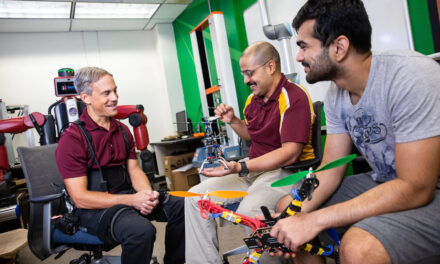
Breakthroughs may pave way to new generations of tiny electronics

ASU electrical engineer David Ferry specializes in studying the fundamental physics involved in the workings of electronic technologies. He’s past editor-in-chief of the Journal of Physics Condensed Matter. Ferry is a Regents’ Professor, the highest status bestowed on faculty at Arizona’s state universities.
Posted: January 18, 2012
Demand for electronic devices that are more compact, mobile and powerful has driven breakthroughs in finding ways to make components such as transistors and microchips smaller and smaller.
Now that these things are being constructed at the atomic scale, there are concerns that the limit of such miniaturization may have been reached.
The worry is that in trying to go even smaller the normal laws of physics will break down, giving way to the unpredictable behavior of quantum mechanics.
But Arizona State University electrical engineer David Ferry is among scientists and engineers sparking talk about the possibility of producing yet another next-generation of tiny electronic devices.
Ferry is a professor of electrical engineering in the School of Electrical, Computing and Energy Engineering, one of ASU’s Ira A. Fulton Schools of Engineering.
He’s also a member of the Department of Physics graduate program faculty in ASU’s College of Liberal Arts and Sciences.
In an article in a recent edition of Science magazine Ferry cites research demonstrating wires that are only a few atoms thick – or even a single atom thick – can still conduct electricity similarly to components in existing larger devices.
The wires still act in accordance with conventional physics rather than producing the expected quantum mechanical effects.
This, Ferry says, potentially opens a door for the semiconductor industry to explore producing a few more generations of miniaturized electronics.
The discovery is being reported on in leading science, technology and engineering news sources, including Physics World, New Scientist, IEEE Spectrum (the news journal of the Institute of Electrical and Electronics Engineers) Tech Week Europe and the Times of India.
Nature magazine
http://www.nature.com.ezproxy1.lib.asu.edu/news/nanoscale-wires-defy-quantum-predictions-1.9747
Editor’s Note: Links are included for informational purposes only. Due to varying editorial policies, news publications may remove or change a link for archival purposes at any time without notice.



































